Ionospheric Variability during the 2020–2021 SSW: COSMIC-2 Observations and WACCM-X Simulations
Abstract
:1. Introduction
2. Observations and Model Simulations
2.1. COSMIC-2 Observations
2.2. WACCM-X Simulations
3. Results and Discussion
4. Summary and Conclusions
Funding
Institutional Review Board Statement
Informed Consent Statement
Data Availability Statement
Acknowledgments
Conflicts of Interest
References
- Matsuno, T. A Dynamical Model of the Stratospheric Sudden Warming. J. Atmos. Sci. 1971, 28, 1479–1494. [Google Scholar] [CrossRef]
- Charlton, A.J.; Polvani, L.M. A New Look at Stratospheric Sudden Warmings. Part I: Climatology and Modeling Benchmarks. J. Clim. 2007, 20, 449–469. [Google Scholar] [CrossRef]
- Pedatella, N.M.; Chau, J.L.; Schmidt, H.; Goncharenko, L.P.; Stolle, C.; Hocke, K.; Harvey, V.L.; Funke, B.; Siddiqui, T.A. How sudden stratospheric warming affects the whole atmosphere. EOS 2018, 99, 35–38. [Google Scholar] [CrossRef]
- Baldwin, M.P.; Ayarzagüena, B.; Birner, T.; Butchart, N.; Butler, A.H.; Charlton-Perez, A.J.; Domeisen, D.I.V.; Garfinkel, C.I.; Garny, H.; Gerber, E.P.; et al. Sudden Stratospheric Warmings. Rev. Geophys. 2021, 59, e2020RG000708. [Google Scholar] [CrossRef]
- Stening, R.J. Electron density profile changes associated with the equatorial electrojet. J. Atmos. Terr. Phys. 1977, 39, 157–164. [Google Scholar] [CrossRef]
- Goncharenko, L.; Zhang, S.R. Ionospheric signatures of sudden stratospheric warming: Ion temperature at middle latitude. Geophys. Res. Lett. 2008, 35, L21103. [Google Scholar] [CrossRef] [Green Version]
- Chau, J.L.; Fejer, B.G.; Goncharenko, L.P. Quiet variability of equatorial E × B drifts during a sudden stratospheric warming event. Geophys. Res. Lett. 2009, 36, L05101. [Google Scholar] [CrossRef]
- Goncharenko, L.P.; Chau, J.L.; Liu, H.L.; Coster, A.J. Unexpected connections between the stratosphere and ionosphere. Geophys. Res. Lett. 2010, 37, L10101. [Google Scholar] [CrossRef]
- Chau, J.L.; Goncharenko, L.P.; Fejer, B.G.; Liu, H.L. Equatorial and Low Latitude Ionospheric Effects During Sudden Stratospheric Warming Events. Space Sci. Rev. 2012, 168, 385–417. [Google Scholar] [CrossRef]
- Goncharenko, L.P.; Harvey, V.L.; Liu, H.; Pedatella, N.M. Sudden Stratospheric Warming Impacts on the Ionosphere–Thermosphere System. In Ionosphere Dynamics and Applications; American Geophysical Union (AGU): Washington, DC, USA, 2021; Chapter 16; pp. 369–400. [Google Scholar] [CrossRef]
- Jin, H.; Miyoshi, Y.; Pancheva, D.; Mukhtarov, P.; Fujiwara, H.; Shinagawa, H. Response of migrating tides to the stratospheric sudden warming in 2009 and their effects on the ionosphere studied by a whole atmosphere-ionosphere model GAIA with COSMIC and TIMED/SABER observations. J. Geophys. Res. Space Phys. 2012, 117, A10323. [Google Scholar] [CrossRef]
- Forbes, J.M.; Zhang, X. Lunar tide amplification during the January 2009 stratosphere warming event: Observations and theory. J. Geophys. Res. Space Phys. 2012, 117, A12312. [Google Scholar] [CrossRef] [Green Version]
- Siddiqui, T.A.; Maute, A.; Pedatella, N.M. On the Importance of Interactive Ozone Chemistry in Earth-System Models for Studying Mesophere-Lower Thermosphere Tidal Changes during Sudden Stratospheric Warmings. J. Geophys. Res. Space Phys. 2019, 124, 10690–10707. [Google Scholar] [CrossRef]
- Fang, T.W.; Fuller-Rowell, T.; Akmaev, R.; Wu, F.; Wang, H.; Anderson, D. Longitudinal variation of ionospheric vertical drifts during the 2009 sudden stratospheric warming. J. Geophys. Res. Space Phys. 2012, 117, A03324. [Google Scholar] [CrossRef] [Green Version]
- Pedatella, N.M.; Richmond, A.D.; Maute, A.; Liu, H.L. Impact of semidiurnal tidal variability during SSWs on the mean state of the ionosphere and thermosphere. J. Geophys. Res. Space Phys. 2016, 121, 8077–8088. [Google Scholar] [CrossRef] [Green Version]
- Oberheide, J.; Pedatella, N.M.; Gan, Q.; Kumari, K.; Burns, A.G.; Eastes, R.W. Thermospheric Composition O/N Response to an Altered Meridional Mean Circulation During Sudden Stratospheric Warmings Observed by GOLD. Geophys. Res. Lett. 2020, 47, e2019GL086313. [Google Scholar] [CrossRef]
- Goncharenko, L.P.; Coster, A.J.; Chau, J.L.; Valladares, C.E. Impact of sudden stratospheric warmings on equatorial ionization anomaly. J. Geophys. Res. Space Phys. 2010, 115, A00G07. [Google Scholar] [CrossRef]
- Anderson, D.; Araujo-Pradere, E.A. Sudden stratospheric warming event signatures in daytime ExB drift velocities in the Peruvian and Philippine longitude sectors for January 2003 and 2004. J. Geophys. Res. Space Phys. 2010, 115, A00G05. [Google Scholar] [CrossRef]
- Maute, A.; Hagan, M.E.; Yudin, V.; Liu, H.L.; Yizengaw, E. Causes of the longitudinal differences in the equatorial vertical ExB drift during the 2013 SSW period as simulated by the TIME-GCM. J. Geophys. Res. Space Phys. 2015, 120, 5117–5136. [Google Scholar] [CrossRef]
- McDonald, S.E.; Sassi, F.; Tate, J.; McCormack, J.; Kuhl, D.D.; Drob, D.P.; Metzler, C.; Mannucci, A.J. Impact of non-migrating tides on the low latitude ionosphere during a sudden stratospheric warming event in January 2010. J. Atmos. Solar-Terrestrial Phys. 2018, 171, 188–200. [Google Scholar] [CrossRef] [Green Version]
- Lin, J.T.; Lin, C.H.; Chang, L.C.; Huang, H.H.; Liu, J.Y.; Chen, A.B.; Chen, C.H.; Liu, C.H. Observational evidence of ionospheric migrating tide modification during the 2009 stratospheric sudden warming. Geophys. Res. Lett. 2012, 39, L02101. [Google Scholar] [CrossRef]
- Lin, C.H.; Lin, J.T.; Chang, L.C.; Liu, J.Y.; Chen, C.H.; Chen, W.H.; Huang, H.H.; Liu, C.H. Observations of global ionospheric responses to the 2009 stratospheric sudden warming event by FORMOSAT-3/COSMIC. J. Geophys. Res. Space Phys. 2012, 117, A06323. [Google Scholar] [CrossRef] [Green Version]
- Anthes, R.A.; Schreiner, W.S. Six new satellites watch the atmosphere over Earth’s equator. EOS 100 2019. [Google Scholar] [CrossRef]
- Yue, X.; Schreiner, W.S.; Pedatella, N.; Anthes, R.A.; Mannucci, A.J.; Straus, P.R.; Liu, J.Y. Space Weather Observations by GNSS Radio Occultation: From FORMOSAT-3/COSMIC to FORMOSAT-7/COSMIC-2. Space Weather 2014, 12, 616–621. [Google Scholar] [CrossRef] [PubMed] [Green Version]
- Schreiner, W.S.; Sokolovskiy, S.V.; Rocken, C.; Hunt, D.C. Analysis and validation of GPS/MET radio occultation data in the ionosphere. Radio Sci. 1999, 34, 949–966. [Google Scholar] [CrossRef]
- Cherniak, I.; Zakharenkova, I.; Braun, J.; Wu, Q.; Pedatella, N.M.; Schreiner, W.S.; Weiss, J.P.; Hunt, D.C. Accuracy Assessment of the Quiet-time Ionospheric F2 peak Parameters as Derived from COSMIC-2 multi-GNSS Radio Occultation. J. Space Weather Space Clim. 2021, 11, 18. [Google Scholar] [CrossRef]
- Chang, L.C.; Lin, C.H.; Liu, J.Y.; Balan, N.; Yue, J.; Lin, J.T. Seasonal and local time variation of ionospheric migrating tides in 2007–2011 FORMOSAT-3/COSMIC and TIE-GCM total electron content. J. Geophys. Res. Space Phys. 2013, 118, 2545–2564. [Google Scholar] [CrossRef]
- Pedatella, N.M.; Forbes, J.M. Evidence for stratosphere sudden warming-ionosphere coupling due to vertically propagating tides. Geophys. Res. Lett. 2010, 37, L11104. [Google Scholar] [CrossRef]
- Lin, J.T.; Lin, C.H.; Lin, C.Y.; Pedatella, N.M.; Rajesh, P.K.; Matsuo, T.; Liu, J.Y. Revisiting the Modulations of Ionospheric Solar and Lunar Migrating Tides During the 2009 Stratospheric Sudden Warming by Using Global Ionosphere Specification. Space Weather 2019, 17, 767–777. [Google Scholar] [CrossRef]
- Danabasoglu, G.; Lamarque, J.F.; Bacmeister, J.; Bailey, D.A.; DuVivier, A.K.; Edwards, J.; Emmons, L.K.; Fasullo, J.; Garcia, R.; Gettelman, A.; et al. The Community Earth System Model Version 2 (CESM2). J. Adv. Model. Earth Syst. 2020, 12, e2019MS001916. [Google Scholar] [CrossRef] [Green Version]
- Neale, R.B.; Richter, J.; Park, S.; Lauritzen, P.H.; Vavrus, S.J.; Rasch, P.J.; Zhang, M. The Mean Climate of the Community Atmosphere Model (CAM4) in Forced SST and Fully Coupled Experiments. J. Clim. 2013, 26, 5150–5168. [Google Scholar] [CrossRef] [Green Version]
- Marsh, D.R.; Mills, M.J.; Kinnison, D.E.; Lamarque, J.F.; Calvo, N.; Polvani, L.M. Climate change from 1850 to 2005 simulated in CESM1(WACCM). J. Clim. 2013, 26, 7372–7391. [Google Scholar] [CrossRef] [Green Version]
- Qian, L.; Burns, A.G.; Emery, B.A.; Foster, B.; Lu, G.; Maute, A.; Richmond, A.D.; Roble, R.G.; Solomon, S.C.; Wang, W. The NCAR TIE-GCM. In Modeling the Ionosphere-Thermosphere System; American Geophysical Union (AGU): Washington, DC, USA, 2014; Chapter 7; pp. 73–83. [Google Scholar] [CrossRef]
- Liu, H.L.; Bardeen, C.G.; Foster, B.T.; Lauritzen, P.; Liu, J.; Lu, G.; Marsh, D.R.; Maute, A.; McInerney, J.M.; Pedatella, N.M.; et al. Development and Validation of the Whole Atmosphere Community Climate Model With Thermosphere and Ionosphere Extension (WACCM-X 2.0). J. Adv. Model. Earth Syst. 2018, 10, 381–402. [Google Scholar] [CrossRef]
- Liu, J.; Liu, H.; Wang, W.; Burns, A.G.; Wu, Q.; Gan, Q.; Solomon, S.C.; Marsh, D.R.; Qian, L.; Lu, G.; et al. First Results From the Ionospheric Extension of WACCM-X During the Deep Solar Minimum Year of 2008. J. Geophys. Res. Space Phys. 2018, 123, 1534–1553. [Google Scholar] [CrossRef]
- Gelaro, R.; McCarty, W.; Suárez, M.J.; Todling, R.; Molod, A.; Takacs, L.; Randles, C.A.; Darmenov, A.; Bosilovich, M.G.; Reichle, R.; et al. The Modern-Era Retrospective Analysis for Research and Applications, Version 2 (MERRA-2). J. Clim. 2017, 30, 5419–5454. [Google Scholar] [CrossRef]
- Smith, A.K.; Pedatella, N.M.; Marsh, D.R.; Matsuo, T. On the Dynamical Control of the Mesosphere–Lower Thermosphere by the Lower and Middle Atmosphere. J. Atmos. Sci. 2017, 74, 933–947. [Google Scholar] [CrossRef]
- Solomon, S.C.; Qian, L. Solar extreme-ultraviolet irradiance for general circulation models. J. Geophys. Res. Space Phys. 2005, 110, A10306. [Google Scholar] [CrossRef] [Green Version]
- Heelis, R.A.; Lowell, J.K.; Spiro, R.W. A model of the high-latitude ionospheric convection pattern. J. Geophys. Res. Space Phys. 1982, 87, 6339–6345. [Google Scholar] [CrossRef]
- Emery, B.A.; Roble, R.G.; Ridley, E.C.; Richmond, A.D.; Knipp, D.J.; Crowley, G.; Evans, D.S.; Rich, F.J.; Maeda, S. Parameterization of the Ion Convection and the Auroral Oval in the NCAR Thermospheric General Circulation Models; Tech. Rep. No. NCAR/TN-491+STR; University Corporation for Atmospheric Research: Boulder, CO, USA, 2012. [Google Scholar] [CrossRef]
- Pedatella, N.M.; Liu, H.L.; Richmond, A.D. Atmospheric semidiurnal lunar tide climatology simulated by the Whole Atmosphere Community Climate Model. J. Geophys. Res. Space Phys. 2012, 117, A06327. [Google Scholar] [CrossRef]
- Rao, J.; Garfinkel, C.I.; Wu, T.; Lu, Y.; Lu, Q.; Liang, Z. The January 2021 Sudden Stratospheric Warming and Its Prediction in Subseasonal to Seasonal Models. J. Geophys. Res. Atmos. 2021, 126, e2021JD035057. [Google Scholar] [CrossRef]
- Cai, X.; Burns, A.G.; Wang, W.; Qian, L.; Pedatella, N.; Coster, A.; Zhang, S.; Solomon, S.C.; Eastes, R.W.; Daniell, R.E.; et al. Variations in Thermosphere Composition and Ionosphere Total Electron Content Under “Geomagnetically Quiet” Conditions at Solar-Minimum. Geophys. Res. Lett. 2021, 48, e2021GL093300. [Google Scholar] [CrossRef]
- Pancheva, D.; Mukhtarov, P.; Andonov, B. Nonmigrating tidal activity related to the sudden stratospheric warming in the Arctic winter of 2003/2004. Ann. Geophys. 2009, 27, 975–987. [Google Scholar] [CrossRef] [Green Version]
- Lieberman, R.S.; Riggin, D.M.; Ortland, D.A.; Oberheide, J.; Siskind, D.E. Global observations and modeling of nonmigrating diurnal tides generated by tide-planetary wave interactions. J. Geophys. Res. Atmos. 2015, 120, 11419–11437. [Google Scholar] [CrossRef]
- Pedatella, N.M.; Liu, H.L.; Richmond, A.D.; Maute, A.; Fang, T.W. Simulations of solar and lunar tidal variability in the mesosphere and lower thermosphere during sudden stratosphere warmings and their influence on the low-latitude ionosphere. J. Geophys. Res. Space Phys. 2012, 117, A08326. [Google Scholar] [CrossRef]
- Pedatella, N.M.; Liu, H. The influence of atmospheric tide and planetary wave variability during sudden stratosphere warmings on the low latitude ionosphere. J. Geophys. Res. Space Phys. 2013, 118, 5333–5347. [Google Scholar] [CrossRef]
- He, M.; Chau, J.L. Mesospheric semidiurnal tides and near-12 h waves through jointly analyzing observations of five specular meteor radars from three longitudinal sectors at boreal midlatitudes. Atmos. Chem. Phys. 2019, 19, 5993–6006. [Google Scholar] [CrossRef] [Green Version]
- Pedatella, N.M.; Fuller-Rowell, T.; Wang, H.; Jin, H.; Miyoshi, Y.; Fujiwara, H.; Shinagawa, H.; Liu, H.L.; Sassi, F.; Schmidt, H.; et al. The neutral dynamics during the 2009 sudden stratosphere warming simulated by different whole atmosphere models. J. Geophys. Res. Space Phys. 2014, 119, 1306–1324. [Google Scholar] [CrossRef]
- McLandress, C. The Seasonal Variation of the Propagating Diurnal Tide in the Mesosphere and Lower Thermosphere. Part I: The Role of Gravity Waves and Planetary Waves. J. Atmos. Sci. 2002, 59, 893–906. [Google Scholar] [CrossRef]
- Liu, H.L.; Wang, W.; Richmond, A.D.; Roble, R.G. Ionospheric variability due to planetary waves and tides for solar minimum conditions. J. Geophys. Res. Space Phys. 2010, 115, A00G01. [Google Scholar] [CrossRef]
- Maute, A.; Hagan, M.E.; Richmond, A.D.; Roble, R.G. TIME-GCM study of the ionospheric equatorial vertical drift changes during the 2006 stratospheric sudden warming. J. Geophys. Res. Space Phys. 2014, 119, 1287–1305. [Google Scholar] [CrossRef]
- Millward, G.H.; Müller-Wodarg, I.C.F.; Aylward, A.D.; Fuller-Rowell, T.J.; Richmond, A.D.; Moffett, R.J. An investigation into the influence of tidal forcing on F region equatorial vertical ion drift using a global ionosphere-thermosphere model with coupled electrodynamics. J. Geophys. Res. Space Phys. 2001, 106, 24733–24744. [Google Scholar] [CrossRef]
- Liu, H.L.; Richmond, A.D. Attribution of ionospheric vertical plasma drift perturbations to large-scale waves and the dependence on solar activity. J. Geophys. Res. Space Phys. 2013, 118, 2452–2465. [Google Scholar] [CrossRef]
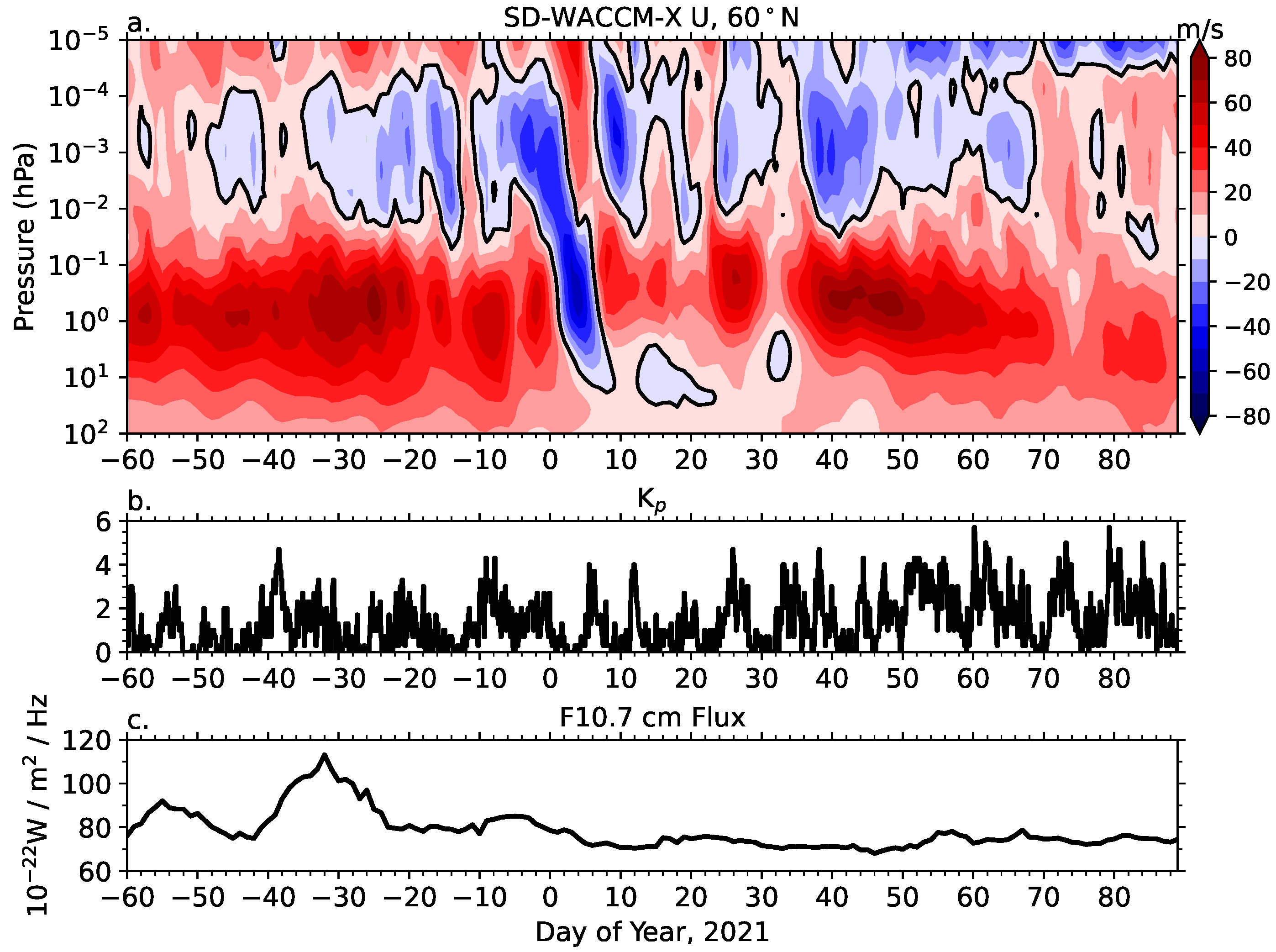

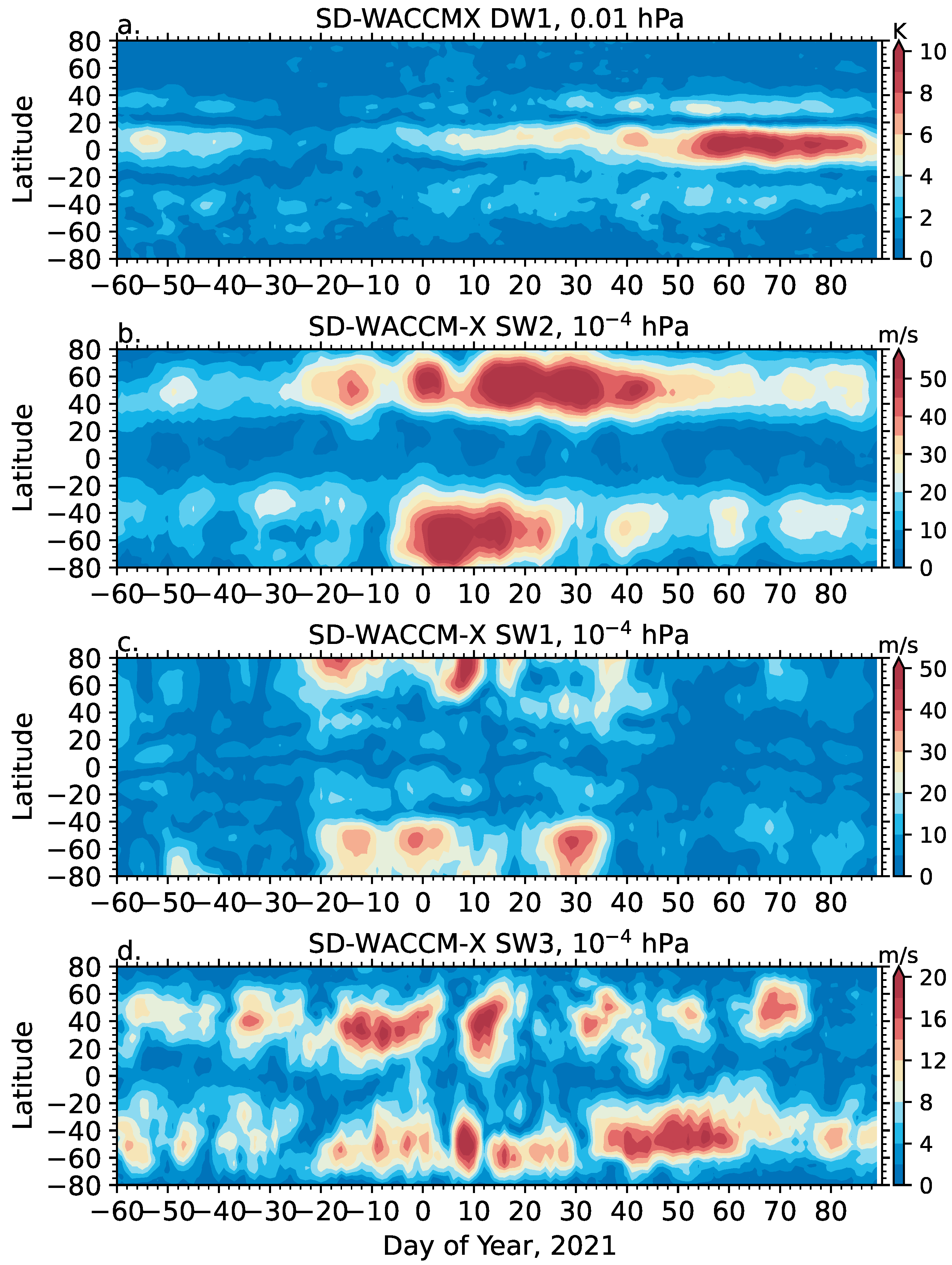
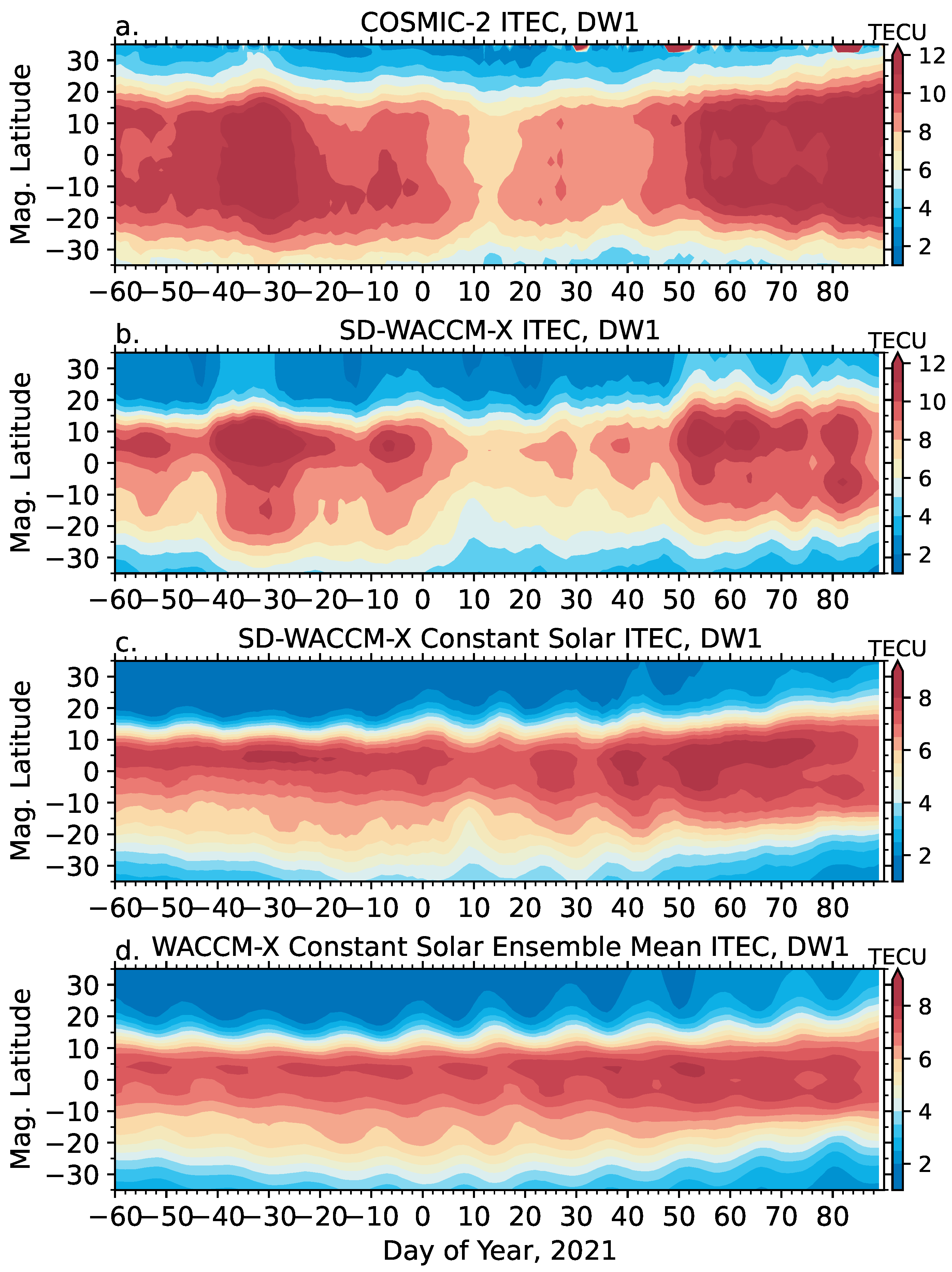
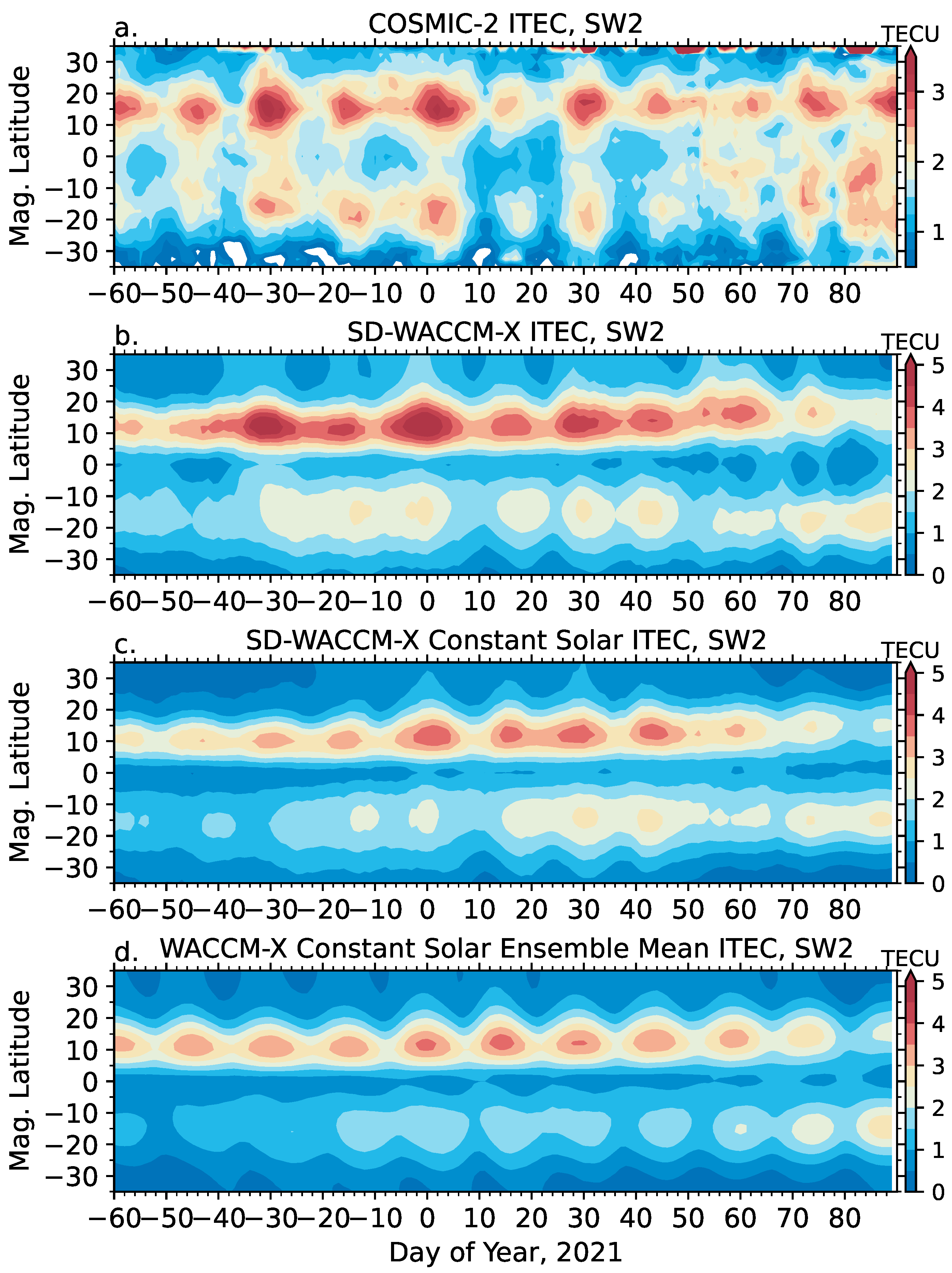
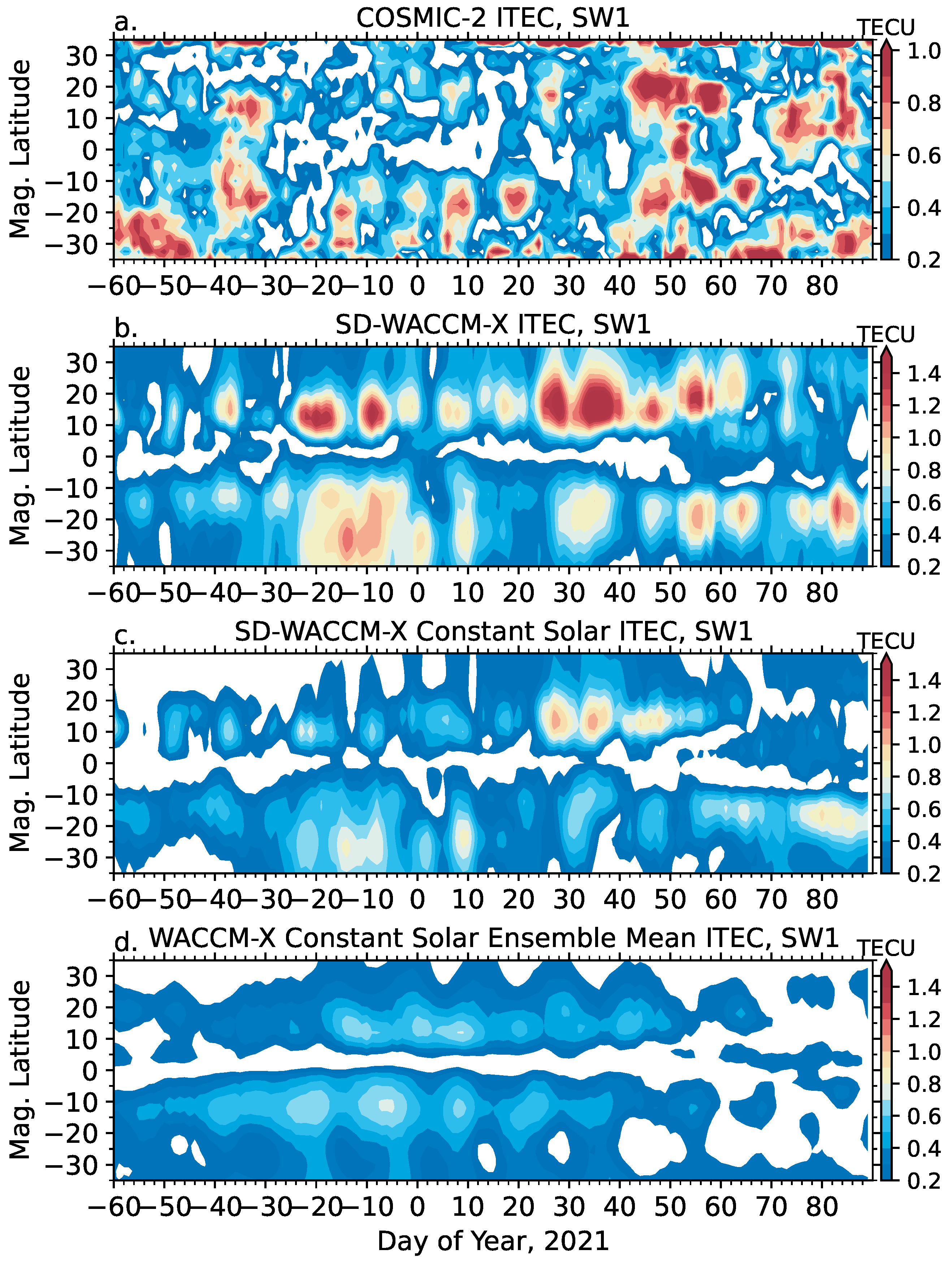

Publisher’s Note: MDPI stays neutral with regard to jurisdictional claims in published maps and institutional affiliations. |
© 2022 by the author. Licensee MDPI, Basel, Switzerland. This article is an open access article distributed under the terms and conditions of the Creative Commons Attribution (CC BY) license (https://creativecommons.org/licenses/by/4.0/).
Share and Cite
Pedatella, N. Ionospheric Variability during the 2020–2021 SSW: COSMIC-2 Observations and WACCM-X Simulations. Atmosphere 2022, 13, 368. https://doi.org/10.3390/atmos13030368
Pedatella N. Ionospheric Variability during the 2020–2021 SSW: COSMIC-2 Observations and WACCM-X Simulations. Atmosphere. 2022; 13(3):368. https://doi.org/10.3390/atmos13030368
Chicago/Turabian StylePedatella, Nicholas. 2022. "Ionospheric Variability during the 2020–2021 SSW: COSMIC-2 Observations and WACCM-X Simulations" Atmosphere 13, no. 3: 368. https://doi.org/10.3390/atmos13030368
APA StylePedatella, N. (2022). Ionospheric Variability during the 2020–2021 SSW: COSMIC-2 Observations and WACCM-X Simulations. Atmosphere, 13(3), 368. https://doi.org/10.3390/atmos13030368





